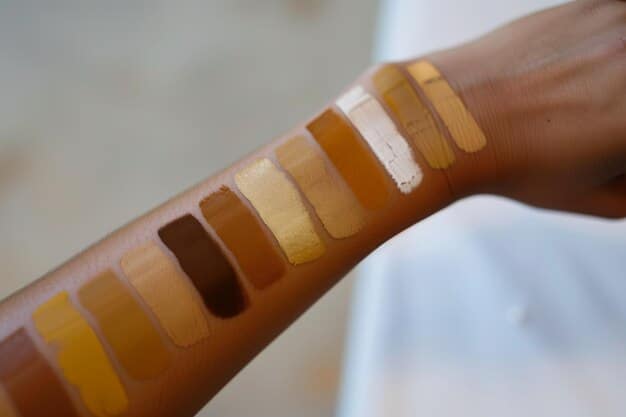The Ultimate Guide to Choosing the Right Foundation for Your Skin Type

The ultimate guide to choosing the right foundation focuses on understanding your skin type (oily, dry, combination, sensitive) and finding the perfect shade match using undertones, swatching, and natural lighting, ensuring a flawless, natural-looking finish.
Finding the right foundation can feel like searching for a needle in a haystack. But with the right knowledge, you can discover a perfect match. This The Ultimate Guide to Choosing the Right Foundation for Your Skin Type (with Shade Matching Tips) will help you navigate the world of foundations and achieve a flawless complexion.
Understanding Your Skin Type
Before diving into foundation formulas and shades, it’s crucial to identify your skin type. This knowledge will guide you toward foundations that complement your skin’s needs and avoid potential problems.
Oily Skin
Oily skin is characterized by excess sebum production, leading to a shiny appearance and a tendency to develop blemishes. Look for foundations designed to control oil and minimize shine.
Dry Skin
Dry skin lacks moisture, resulting in a tight, flaky, or uncomfortable feeling. Hydrating foundations can help replenish moisture and create a smoother complexion.
Here are the key factors to consider when assesing your skin type:
- Sebum Production: How oily or dry does your skin feel throughout the day?
- Pore Size: Are your pores large and visible, or small and barely noticeable?
- Sensitivity: Does your skin react easily to new products or environmental factors?
- Common Issues: Do you frequently experience breakouts, dryness, or redness?
Choosing the right foundation for your skin type is the first step towards achieving a flawless and comfortable makeup look. By understanding your skin’s unique characteristics, you can select a foundation that addresses its specific needs and enhances its natural beauty.
Choosing the Right Foundation Formula
The foundation market is overflowing with options, each offering a unique texture, coverage level, and finish. Understanding the different formulas will help you narrow down your choices.
Liquid Foundations
Liquid foundations offer a versatile option for all skin types. They can range from light to full coverage and come in various finishes, like matte, satin, and dewy.
Cream Foundations
Cream foundations are typically richer and more hydrating than liquids. They’re ideal for dry or mature skin, providing a smooth, radiant finish. Cream foundations often offer medium to full coverage.
Consider these additional foundation types:
- Powder Foundations: Great for oily skin, providing a matte finish and oil absorption.
- Stick Foundations: Convenient for travel and touch-ups, offering buildable coverage.
- Tinted Moisturizers: Provide sheer coverage and hydration, perfect for a natural look.
Selecting the right foundation formula enhances your natural beauty and ensures a comfortable wear. By considering your skin type and desired coverage, you can discover the perfect formula that meets your unique needs.

Understanding Your Undertones
Finding the perfect foundation shade goes beyond simply matching your skin tone. Understanding your undertones—the subtle hues beneath the surface—is crucial for achieving a natural, seamless blend.
Warm Undertones
Warm undertones lean toward yellow, peach, or golden hues. Foundations with similar warm undertones will complement your skin the best.
Cool Undertones
Cool undertones have hints of pink, red, or blue. Look for foundations with cool undertones to avoid an ashy or unnatural look.
Here are tips to determine your undertones:
- Vein Test: Look at the veins on your wrist. Blue or purple veins suggest cool undertones, while green veins indicate warm undertones.
- Jewelry Test: How does your skin look with gold versus silver jewelry? Gold tends to flatter warm undertones, while silver complements cool undertones.
- White Fabric Test: Hold a white piece of fabric next to your face. Does your skin appear more yellow or pink in comparison?
Understanding and matching your foundation to your undertones is essential for a seamless and natural makeup look. Accurate undertone matching prevents the common issue of foundation appearing mismatched or unnatural, ensuring a flawless finish.
Shade Matching Techniques
Now that you understand your skin type, foundation formulas, and undertones, it’s time to explore shade matching techniques. Properly matching your foundation shade ensures a natural, flawless look that enhances your complexion.
Swatching
Swatching involves applying small amounts of foundation to your skin to see how it blends. The best places to swatch are your jawline, chest, or forehead.
Natural Lighting
Always test foundation shades in natural lighting. Indoor lighting can distort the color and make it difficult to find the perfect match.
Consider these additional tips for shade matching:
- Blend Thoroughly: Blend the foundation swatch completely to see how it looks once it’s fully absorbed into your skin.
- Wait a Few Minutes: Give the foundation a few minutes to oxidize, as the color may slightly change after application.
- Check in a Mirror: Look at your face in a mirror to assess how the foundation blends with your neck and chest.
Mastering shade matching techniques ensures a foundation that enhances, rather than masks, your natural skin tone. Consistent practice and attention to detail will lead to successful shade matching, providing a flawless makeup look.
Common Foundation Mistakes and How to Avoid Them
Even with the right foundation, common mistakes can hinder your quest for a flawless complexion. Recognizing and avoiding these pitfalls will greatly improve your makeup application.
Applying Too Much Foundation
Applying too much foundation can create a heavy, cakey look. Start with a small amount and build coverage as needed.
Using the Wrong Tools
The right tools can make a significant difference in your foundation application. Use a brush, sponge, or your fingers, depending on the formula and desired coverage.
Avoid these further foundation errors:
- Skipping Primer: Primer creates a smooth base and helps your foundation last longer.
- Forgetting to Blend: Thorough blending is essential to avoid harsh lines and an unnatural look.
- Not Setting with Powder: Setting your foundation with powder helps control oil and prolong its wear.
By knowing and avoiding these errors, you will improve the overall look and wear of your foundation application. With attention to detail, you can create a smooth, natural, and long-lasting makeup look.

Tips for Long-Lasting Foundation
Achieving a flawless foundation look isn’t just about the initial application; it’s also about making it last. Use these tips to keep your foundation looking fresh and intact throughout the day.
Proper Skincare
Start with a clean, moisturized face. Proper skincare provides a smooth canvas for foundation application.
Setting Spray
Use a setting spray to lock in your foundation and prevent it from transferring or fading.
In addition, consider the following to make your foundation last longer:
- Blotting Papers: Carry blotting papers to absorb excess oil throughout the day.
- Hydrating Mist: Use a hydrating mist to refresh your skin and prevent your foundation from looking dry or cakey.
- Avoid Touching Your Face: Touching your face can transfer oils and dirt, causing your foundation to break down.
Implementing these tips ensures that your foundation looks fresh and flawless for hours on end. By combining the right products and techniques, you can enjoy long-lasting results and a consistently polished appearance.
| Key Point | Brief Description |
|---|---|
| ✨ Skin Type | Identify if you’re oily, dry, or combination for the right formula. |
| 🎨 Undertones | Determine warm, cool, or neutral tones for a natural match. |
| 💡 Shade Matching | Swatch and test in natural light to avoid mismatches. |
| ✅ Application | Use proper tools and blending techniques for a flawless finish. |
Frequently Asked Questions
▼
Observe how your skin feels throughout the day. If it’s shiny and oily, you likely have oily skin. If it feels tight or flaky, you might have dry skin. Combination skin features both oily and dry areas.
▼
Check the color of your veins on your wrist. Blue veins suggest cool undertones, while green veins suggest warm. You can also see how gold or silver jewelry looks against your skin – warm undertones pop with gold.
▼
A correctly matched foundation enhances your natural skin tone and ensures a seamless appearance, rather than masking or clashing with your complexion. It prevents an unnatural or “off” look.
▼
Start with a clean and moisturized face, use a primer, apply foundation in thin layers, set it with powder, and finish with a setting spray. Avoid touching your face and carry blotting papers to control oil.
▼
Avoid applying too much foundation, using the wrong tools, skipping primer, failing to blend thoroughly, and forgetting to set with powder. These can lead to a cakey or unnatural appearance.
Conclusion
Choosing the right foundation involves a holistic approach, considering your skin type, undertones, formula preferences, and application techniques. By following this comprehensive guide, you can confidently select and apply a foundation that enhances your natural beauty and provides a flawless, long-lasting finish.





